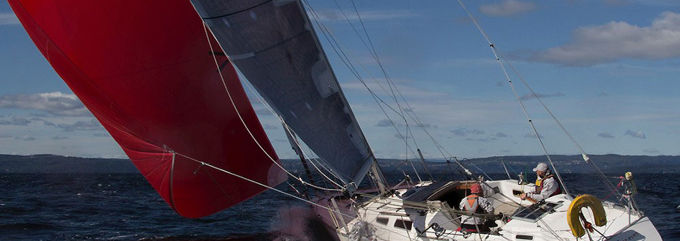
There is a lot to take in to consideration when deciding what kind of sail set-up you should have on your boat for long-distance cruising.
Safety for the sailors, durability and efficiency of the sails are important factors, but maybe the most important one is to choose right to be sure you get the best ever sailing adventure.
After 18 years of sail making at Elvstrøm Sails in Norway, Karl Otto and his wife Maren Magda decided to pursue a dream. Sailed from Norway south through the coast of Europe to the Azores, to the Canaries, joined the ARC crossing the Atlantic, headed west to Panama into Pacific Galapagos, arrived at the US west coast, took part in the Trans Pacific race, set off for Hawaii, sold their Wasa 55 – bought a cat and headed back for Europe. Karl Otto is back in Elvstrøm Sails and shares his thoughts and experiences about sail set-up for long-distance sailing.
“If you are going blue water cruising on the big ocean you will sail downwind most of the miles in fantastic sailing conditions between the destinations. And in these situations you will enjoy your downwind sails to the full. Even though most of the miles are in fantastic sailing conditions, you will also experience that a lot of the time out on the ocean you will have light winds, and once in a while, even upwind sailing. Remember that when you plan your sail set-up.
I have seen many different boat- and rig types out there. Most of them still have one mast with a boom for the mainsail, and they have a furling system for the furling headsail. Many sailors have proven that it is possible, and in fact they have had nice long ocean crossings with these two sails. If you choose to sail with this set-up, however, you should definitely also bring a pole to make it possible to fly the headsail butterfly style, stable on the opposite side of the mainsail.
Other solutions
If you choose to bring one more sail, a heavy weather jib - used flying on a 2:1 halyard - could be a good solution. In addition to being used when sailing upwind in heavy wind conditions, which again saves the primary headsail since it will be furled up, the heavy weather jib has several more very good wind angles to be used at. Butterfly sailing with main and primary headsail, makes room for the heavy weather jib – sheeted on the same side as the mainsail. This will make it more comfortable to be on board as the cross swell and movements on board will be slowed down. In addition, this sail can also be used as staysail with other headsails or the spinnaker.
If your intentions are to sail as much as possible and not to use the engine too much, but still not drift around in very light winds, you should consider bringing a Code 0. This is a sail that will bring your boat up to hull speed already at as light winds as 5-8 knot wind speed.
To get the max out of the sailing adventure, to involve your crew on board and enjoy the art of sailing, a spinnaker (symmetric asymmetric or maybe even both) will be great fun to have on board. Crossing the Atlantic from Europe to the Caribbean may give you up to 10-15 days of fantastic downwind sailing. You may regret that you did not bring the sail that makes the adventure totally unforgettable!
A while after we departed for our trip, Elvstrøm Sails launched the Blue Water Runner. This is also a “flying” sail which is set and taken down controlled while furled in. When sailing at wind angles between 155 and 180 degrees this sail, which in fact is a twin furling sail with one luff, will furl out to both sides and “catch the wind” from a large area. For cruising, this sail can also be used as an alternative to both the code 0 and the spinnaker, as you fold the two cloths together and use the sail on the same side as your mainsail when sailing between 80 and 130 degrees true wind.
As we on our tour also competed in the transpac race, finished at second place, the symmetric and asymmetric set-up was however the right solution for us.”
Wasa 55 - Cubaneren's sails (for 20000 NM including the Transpac race)
Mainsail – EPEX – double taffeta – technora
Self tacking “fat furl” furling jib – EPEX – Single inside taffeta – technora
Flying heavy weather jib – Radial laminate
Code 0 – Aramid, radial laminate
A5 (asymmetric), used on top down furler
S2 (symmetric)
S4 (symmetric)
Flying storm jib
Trysail